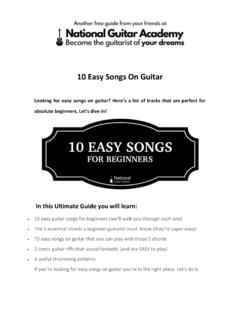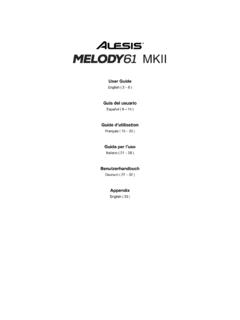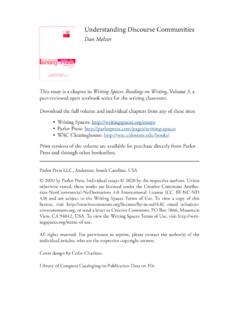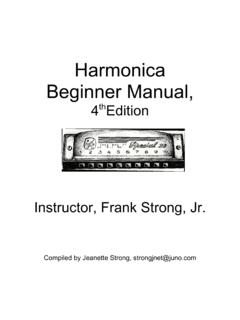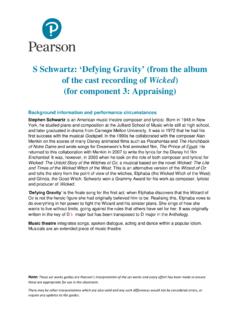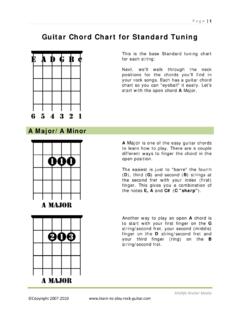Transcription of MUSICAL ANALYSIS WRITING GUIDE 2012 edition
1 MUSICAL ANALYSIS WRITING GUIDE THE CRITERIA In WRITING your essay, the only thing you really need to do is fulfill the marking criteria. Let s look closely at what the criteria says. The student evaluates music by thoroughly deconstructing the repertoire, and determining the manipulation of, and relationships between, identified MUSICAL elements and compositional devices, communicating detailed and substantiated judgments about how these relate to context and genre and the expressed style. That s a bit wordy isn t it? Sometimes educational language is a bit more complicated than it needs to be.
2 Let s try and simplify it. The two most important words here are deconstruction and evaluation, in fact, that s the only two things required of your essay. You need to deconstruct the repertoire and then evaluated it. To DECONSTRUCT means to identify: MUSICAL elements and how they ve been used by the artist (pitch, rhythm, timbre etc) compositional devices (repetition, sequence, inversion, randomness, serialism, etc) You should also identify if/how these two things relate to each other (for instance, maybe each time the music repeats the artist plays more softly?)
3 To EVALUATE means to make judgments about how everything above relates to: The songs context (time/place/history/production values etc) The songs genre (pop, rock etc) The songs or composers style (fun, sexy, epic, silly, carefree, intense etc) DECONSTRUCTION (Don t just listen ) Usually when we listen to music, we listen passively. In other words, we re just letting the music soak in slowly the more often we hear it. We re not listening for anything in particular, just enjoying it. That s fine, but it won t help you write an essay.
4 In order to deconstruct the music, you need to listen actively. That means you need to know what you re looking for before you begin listening. A good method is to pick one MUSICAL element (pitch for instance) and listen to the entire song focusing on just that. Then listen again focusing on a different MUSICAL element. Make a list of everything you notice. By the time you ve written notes on all the elements, you will have listened to the music heaps of times and will have hopefully started to form more complex opinions.
5 These opinions will be the basis for your evaluations. Unfortunately, a list of observations about the MUSICAL elements isn t an essay. Don t fall into the trap of simply making lists of MUSICAL facts. Eg: The key is G, the melody notes are from G major, it is in 4/4, The tempo is 130bpm. Unless you explain why those things are significant, why they contribute to the artist s vision or the listener s experience, they are meaningless facts. EVALUATION (Find an angle) To evaluate effectively, you need an angle, just like a journalist.
6 You need to have opinions and be able to justify them. Here s an example of a raw opinion. The harmonic structure in Take Me Out by Franz Ferdinand shows more complexity than punk or grunge This statement might be true, but why? Where s the evidence? Without identifying MUSICAL elements, compositional devices and their relationships, this opinion carries no weight. Let s try again. The following excerpt from the Franz Ferdinand exemplar paper (available on the MIC website) shows the same opinion but in this case it s been properly fleshed out and justified with evidence: Harmonically the song (Take me out) stays in the key of Em, which is one thing that ties the two halves of the song together.
7 All the chords are partial triads such as Em, D and G (see Figure #1) however some of them are slash chords with different bass notes such as Em/A and D/B in the first verse (0:07- 0:33). The A major chords in the Prechorus don t belong in the key but when grouped with Em and G form a combination of chords that are quite common in rock. I should mention however that Em/A (A, E, G) could be interpreted as Am7, and that D/B (B, D, A) could be interpreted as Bm7. But most charts show them as slash chords, which probably reflects the simpler approach of many guitarists.
8 However you name them, the way those chords are voiced between the instruments is a little more creative. Each guitar (including the bass) is playing single notes which blend together to create wider chord voicings that no single guitar could really play on it s own (see figure #2). This can probably be heard best in the first verse (bars 5 to 20) with big leaps . Cleverly thought out guitar parts like this are definitely a step beyond what you d normally hear in Punk or Grunge. Figure #1 Take me out chords chart excerpt (based on chords from and aural transcription) INTRO |Em | | | | VERSE 1 |Em/A |D |G D/B |Em | |Em/A |D |G D/B |Em | |Em/A |D |G D/B |Em | |Em/A |D |G D/B |Em | PRECHORUS |G A |Em |G A |Em | |G A |Em | | | Figure #2 Take me out Verse tablature.
9 Guitars 1 & 2 (from ) Em/A D G D/B Em Gtr 1 |-----------------|-----------------|--- ------------------|--------------------- ----| |-----------------|-----------------|--- ------------------|--------------------- ----| |-----------------|-----------------|--- ------------------|--------------------- ----| |-5-5-5-5-5-5-5-5-|-4-4-4-4-4-4-4-4S|=9- -9--9--9--7-7-7-5-|-5--5--5--5--5------- ----| |-----------------|-----------------|--- ------------------|----------------5--5- -7--| |-----------------|-----------------|--- ------------------|--------------------- ----| | Gtr 2 |-----------------|-----------------|--- ------------------|--------------------- ----| |-----------------|-----------------|--- ------------------|--------------------- ----| |-----------------|-----------------|--- ------------------|--------------------- ----| |-----------------|-----------------|--- ------------------|--------------------- ----| |-7-7-7-7-7-7-7-7-|-9-9-9-9-9-9-9-9-|-10 -10-10-10-9-9-9-9-|-7--7--7--7--7--7--7- -7--| |-----------------|-----------------|--- ------------------|--------------------- ----| | Bass |-----------------|-7-7-7-7-7-7-7-7-|--- ------------------|--------------------- ----|
10 |-7-7-7-7-7-7-7-7-|-----------------|-5- -5--5--5--9-9-9-9-|-14-14-14-14-14-14-14 -14-| |-----------------|-----------------|--- ------------------|--------------------- ----| |-----------------|-----------------|--- ------------------|--------------------- ----| RIGHT OR WRONG? In WRITING an essay, you may be worried about saying something and being wrong. The thing is, being right or wrong is not as important as justifying your opinion. Music is subjective (as you can tell from my example above), often there is no such thing as right or wrong. So argue away to your heart s content, as long as you can back it up.

